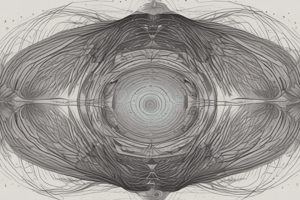Podcast
Questions and Answers
What does the Capacity theory of Attention suggest about human capabilities?
What does the Capacity theory of Attention suggest about human capabilities?
- Humans can perform unlimited tasks at once.
- Humans have a limited amount of attention for tasks. (correct)
- Humans can always multitask effectively.
- Humans require less attention for easier tasks.
In the context of divided attention, how much more is the risk of accidents when using cell phones while driving?
In the context of divided attention, how much more is the risk of accidents when using cell phones while driving?
- 5 times more
- 2 times more
- 3 times more
- 4 times more (correct)
What does the term 'inattentional blindness' refer to?
What does the term 'inattentional blindness' refer to?
- Forgetting where you placed an object.
- Not noticing something you are looking at. (correct)
- Being distracted by multiple stimuli.
- Failing to recognize an object because it is too small.
What is the primary focus of Treisman's feature Integration theory?
What is the primary focus of Treisman's feature Integration theory?
What do action slips primarily result from?
What do action slips primarily result from?
In Treisman and Schmidt's study, what occurred when participants focused on shapes instead of numbers?
In Treisman and Schmidt's study, what occurred when participants focused on shapes instead of numbers?
What is meant by the 'feature present/feature absent effect' in visual search tasks?
What is meant by the 'feature present/feature absent effect' in visual search tasks?
What defines 'change blindness' in cognitive psychology?
What defines 'change blindness' in cognitive psychology?
What is the main concept behind Donders' reaction time experiment?
What is the main concept behind Donders' reaction time experiment?
What did Ebbinghaus contribute to the understanding of memory?
What did Ebbinghaus contribute to the understanding of memory?
What does the concept of structuralism focus on?
What does the concept of structuralism focus on?
How did John Watson challenge structuralism?
How did John Watson challenge structuralism?
What is the primary focus of cognitive neuroscience?
What is the primary focus of cognitive neuroscience?
Which part of the neuron is responsible for transmitting electrical signals?
Which part of the neuron is responsible for transmitting electrical signals?
What is the role of neurotransmitters in neuron communication?
What is the role of neurotransmitters in neuron communication?
What does the 'where pathway' in perception refer to?
What does the 'where pathway' in perception refer to?
What did Treisman's attenuation theory propose regarding selective attention?
What did Treisman's attenuation theory propose regarding selective attention?
How does the concept of 'divided attention' differ from selective attention?
How does the concept of 'divided attention' differ from selective attention?
What phenomenon does the Stroop effect illustrate?
What phenomenon does the Stroop effect illustrate?
What is the primary function of the frontal lobe?
What is the primary function of the frontal lobe?
What do feature detectors in the brain respond to?
What do feature detectors in the brain respond to?
Which model describes how information is processed in stages, similar to a computer?
Which model describes how information is processed in stages, similar to a computer?
Flashcards are hidden until you start studying
Study Notes
Chapter 1: Cognitive Psychology and Its Foundations
- Cognitive psychology studies human mental processes, focusing on how people think, learn, and remember.
- Donders pioneered the use of mental chronometry, employing reaction time experiments to measure cognitive processes.
- Differentiates between Simple RT tasks (one response) and Choice RT tasks (multiple responses); the difference indicates decision-making time.
- Ebbinghaus focused on memory, conducting experiments on nonsense word memorization, revealing that shorter intervals between retrieval enhance learning efficiency.
- Introduced the concept of "savings" to measure memory retention through relearning, leading to the Forgetting Curve.
- Wundt, the founder of psychology, introduced structuralism, breaking experiences down into sensations.
- Structuralism relied on analytic introspection, which proved unreliable due to subjective variability among individuals.
- Watson's behaviorism challenged structuralism, emphasizing observable behavior over mental processes and demonstrating classical conditioning effects.
- BF Skinner's operant conditioning demonstrated that consequences shape behavior, with rewarded actions increasing frequency while punished actions decrease it.
- Chomsky criticized behaviorism by highlighting novel language development in children, leading to the proposal of an inborn language capacity.
- Tolman's experiments with rats established the existence of cognitive maps, contradicting behaviorist views that behavior was solely a response to conditioning.
- The cognitive revolution framed computers as models for understanding human cognition, marking a shift to internal mental processes.
- Information processing models describe cognition as occurring in stages, reflecting how computers operate.
- Structural models physically represent cognitive functions, while process models depict the mechanisms through flow diagrams.
Chapter 2: Cognitive Neuroscience and Nervous System
- Cognitive neuroscience examines the physiological basis of cognition, focusing on the nervous system's mechanisms.
- The nervous system is divided into the central nervous system (CNS) and the peripheral nervous system (PNS).
- Neurons consist of axons (transmit signals), dendrites (receive signals), and cell bodies (sustain the neuron).
- Action potentials are electrical signals that travel along neurons, with firing rates indicating the intensity of the stimuli.
- Synapses facilitate chemical communication between neurons via neurotransmitters; they can be excitatory or inhibitory.
- Neural representation defines how information is stored in the brain.
- Hubel and Wiesel discovered feature detectors in the visual system, differentiating between simple and complex neurons responding to specific stimuli.
- Hierarchical processing builds complex representations from basic sensory inputs, flowing from lower to higher brain areas.
- Knowledge can be coded in three ways: specificity, sparse coding, and population coding.
- Localization of function identifies specific brain areas assigned to distinct cognitive functions.
- The cerebral cortex comprises four lobes: frontal (action coordination), occipital (visual processing), temporal (auditory, language, perception), and parietal (physical sensation processing).
- The limbic system includes structures such as the hippocampus (memory), amygdala (emotion), and thalamus (sensory processing).
- Localizations of brain function include areas specifically for perception (FFA, PPA, EBA) and language (Broca's area for production, Wernicke's area for comprehension).
- Damage to specific brain areas may disrupt particular processing, highlighting brain interconnectivity.
- Advanced imaging techniques (PET, fMRI, DTI) assess brain activity and structural connectivity.
- Event-Related Potentials (ERPs) measure brain responses to stimuli, excelling in temporal resolution but lacking spatial precision.
Chapter 3: Sensation, Perception, and Attention
- Sensation involves absorbing raw sensory data, while transduction converts that energy into neural signals.
- Attention denotes focused mental energy on incoming information, leading to perception—interpreting sensory signals.
- Perception is shaped by personal experiences and may not represent the world accurately.
- Bottom-up processing starts with sensory data, building recognition from components.
- The Recognition by Components theory (geons) posits that three-dimensional objects consist of simple shapes, though criticized for oversimplification.
- Top-down processing relies on prior knowledge and inferences to interpret sensory information.
- Helmholtz's theory of unconscious inference suggests that previous knowledge influences perception.
- The likelihood principle states that perception is guided by the most probable interpretations of sensory input.
- Gestalt laws of perceptual organization describe human tendencies in visual perception, including similarity, proximity, and continuity principles.
- Heuristics are mental shortcuts for decision-making; algorithms provide guaranteed solutions but require more time.
- The oblique effect emphasizes that humans notice vertical and horizontal lines more easily.
- The occlusion heuristic suggests that occluded objects are perceived as continuing behind the covering object.
- The Greeble study demonstrated experiment-dependent plasticity, where neural adaptations occur through exposure to stimuli.
- The "what" pathway (identifying objects) correlates with the temporal lobe, while the "where" pathway (locating objects) is connected to the parietal lobe.
- Brain ablation studies reveal functional deficits tied to specific damage.
- Single and double dissociations help distinguish between different cognitive functions based on damage outcomes.
Chapter 4: Attention Mechanisms
- Selective attention allows the focus on specific messages while ignoring others, exhibiting limited capacity and timing.
- Cherry’s Dichotic Listening Study showed participants could identify physical characteristics of ignored messages but not their meaning.
- The cocktail party effect illustrates the ability to recognize salient information (like hearing one's name) in noisy environments.
- Early selection models, such as Broadbent's filter model, propose filtering information early based on physical characteristics before meaning is processed.
- Evidence against early selection includes findings from Moray, Treisman, and Corteen & Wood, demonstrating that meaning can influence attention.
- Treisman’s Attenuation Theory suggests that both attended and unattended messages are processed, with the attended message occurring with greater strength.
- Late selection models indicate that selection occurs after meaning has been processed, as shown in McKay's experiment.
- The Stroop effect highlights automatic processes interfering with attentional tasks, complicating bottom-up visual processing.
- Overt attention involves direct eye movements (saccades and fixations) studied through eye tracking techniques.
- Bottom-up determinants of eye movement focus on stimulus salience, while top-down determinants involve scene schema and task demands.
- Covert attention allows directional focus without eye movement, evidenced by pre-cueing studies.
- Object-based visual attention suggests that attention can be allocated based on the object rather than solely spatially.
Chapter 4: Divided Attention and Its Effects
- Divided attention refers to the capacity to perform multiple tasks simultaneously.
- Spelke et al. demonstrated through studies that practice increases the ability to multitask effectively.
- Attention capacity limits the number of tasks manageable at once, influenced by arousal and allocation strategies.
- The divided attention driving study showed a fourfold increase in accident risk when using cell phones while driving.
- Strayer and Johnson's studies confirmed that phone use, whether handheld or not, delays reaction times and increases missed signals.
- Inattentional blindness describes failures to notice visible objects when focused elsewhere, demonstrated by Mack and Rock's experiments on line lengths.
- Change blindness occurs when significant changes to a scene go unnoticed without concentrated effort.
- Action slips can result from various failures, including storage, test, sub-routine, discrimination, and program assembly errors.
- Treisman’s Feature Integration Theory posits that attention is required to combine features of objects correctly.
- Illusory conjunctions result from feature misbinding when attention is diverted, as seen in Treisman and Schmidt's study.
- Visual search tasks highlight variables affecting the ease of locating targets, including feature presence and distractor similarity.
- The isolated feature/combined feature effect distinguishes between parallel and serial processing methods in visual searches.
Studying That Suits You
Use AI to generate personalized quizzes and flashcards to suit your learning preferences.


